Schoenus megacarpus
Schoenus megacarpus is a species of sedge endemic to the south-central region of South Africa.[1]
| Schoenus megacarpus | |
|---|---|
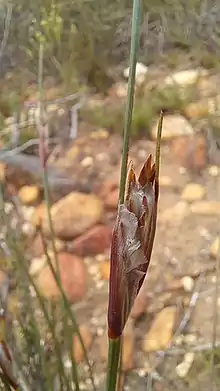 | |
| Bignut veldrush | |
| Scientific classification | |
| Kingdom: | Plantae |
| Clade: | Tracheophytes |
| Clade: | Angiosperms |
| Clade: | Monocots |
| Clade: | Commelinids |
| Order: | Poales |
| Family: | Cyperaceae |
| Genus: | Schoenus |
| Species: | S. megacarpus |
| Binomial name | |
| Schoenus megacarpus T.L.Elliott & Muasya | |
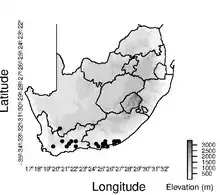 | |
| Documented collection localities in South Africa | |
Diagnostic characters
Key diagnostic characters of S. megacarpus are its primary inflorescence bracts that are expanded proximally with membranaceous extensions.[1] In addition, the bases of the flowering stems are often reddish.[1] This species tends to have longer spikelets and nutlets compared to other species in the S. compar - S. pictus and allies group.[1]
Schoenus megacarpus appears similar to Schoenus compar; however, it does not have the viscous flowering stems and inflorescences that are present in S. compar.[1] Furthermore, S. megacarpus has red culm bases, whereas those of S. compar are usually ivory.[1] Another key difference is that the primary inflorescence bracts of S. megacarpus have primary inflorescence bracts that are expanded proximally and have lateral membranaceous extensions.[1]
Similar to other sedges, plants in this group are very difficult to identify. It appears that part of this problem is caused by the tendency of the southern African Schoenus to form hybrids with each other.[2] However, hybridization is yet to be observed in S. megacarpus.[1]
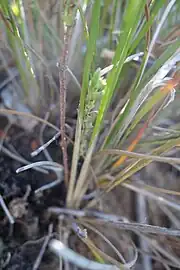 Base of culm with membranaceous sheaths
Base of culm with membranaceous sheaths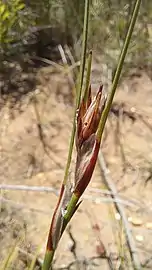 Flowering head (inflorescence)
Flowering head (inflorescence)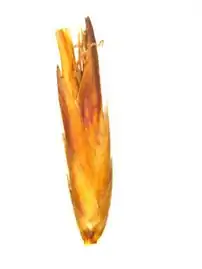 Spikelet
Spikelet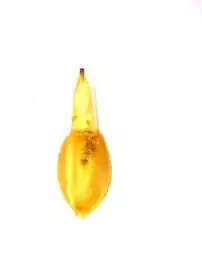 Nutlet
Nutlet
Taxonomy
Schoenus megacarpus is a species in family Cyperaceae, tribe Schoeneae.[3] Other notable genera in tribe Schoeneae include Lepidosperma, Oreobolus, Costularia, Tetraria and Gahnia.[3][4][5] The most closely related species to S. megacarpus are other southern African Schoenus species, specifically, species in the S. compar – S. pictus group.[1]
Southern African Schoenus were once classified as Tetraria; however, based on molecular and morphological differences, we now know that the two groups are evolutionary distinct.[6] To ensure that this group of sedges is monophyletic (i.e. the genus only has closely related species), several species of Epischoenus and the southern African Tetraria were transferred into Schoenus.[6] In the field, the southern African Schoenus can be distinguished from Tetraria species by their lack of stem leaves and the absence of reticulate sheaths at the bases of the flowering stems.[6]
Distribution and ecology
Schoenus megacarpus grows throughout south-central South Africa, with its distribution ranging from the Anysberg Nature Reserve in the west to the Grahamstown area in the east.[1]
Most reports of this species are from high mountain slopes (above 1000 m) surrounded by fynbos vegetation.[1] However, eastern collections of this species come from grassland vegetation at lower elevations.[1]
Images
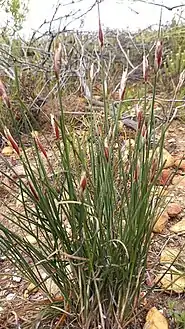 Growth form of Schoenus megacarpus
Growth form of Schoenus megacarpus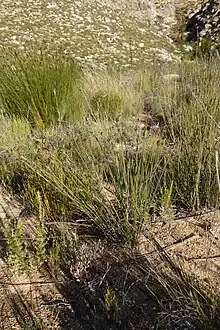 Growth form of Schoenus megacarpus
Growth form of Schoenus megacarpus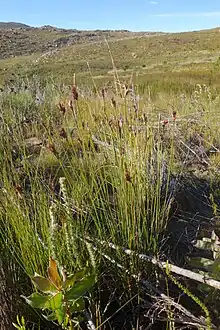 Growth form of Schoenus megacarpus
Growth form of Schoenus megacarpus Flowering heads
Flowering heads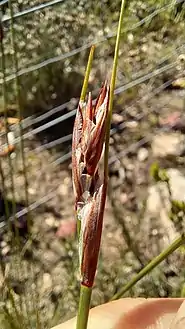 Flowering heads
Flowering heads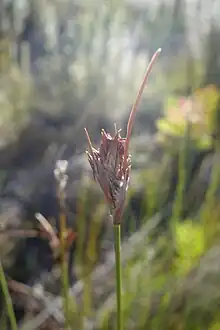 Flowering head
Flowering head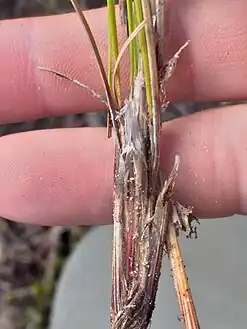 Bases of flowering stems
Bases of flowering stems
References
- Elliott, T.L.; Muasya, A.M. (2018). "A taxonomic revision of Schoenus compar – Schoenus pictus and allies (Cyperaceae, tribe Schoeneae) with three new species described from South Africa". South African Journal of Botany. 114: 303–315. doi:10.1016/j.sajb.2017.11.020.
- Levyns, M. (1947). "Tetraria and related genera, with special reference to the flora of the Cape Peninsula". Journal of South African Botany. 13: 73–93.
- Elliott, T.L.; Barrett, R.L.; Muasya, A.M. (2019). "A taxonomic revision of Schoenus cuspidatus and allies (Cyperaceae, tribe Schoeneae)—Part 1". South African Journal of Botany. 121: 519–535. doi:10.1016/j.sajb.2018.11.021.
- Viljoen, J.-A.; Muasya, A.M.; Barrett, R.L.; Bruhl, J.J.; Gibbs, A.K.; Slingsby, J.A.; Wilson, K. L.; Verboom, G.A. (2013). "Radiation and repeated transoceanic dispersal of Schoeneae (Cyperaceae) through the southern hemisphere". American Journal of Botany. 100 (12): 2494–2508. doi:10.3732/ajb.1300105.
- Larridon, I.; Bauters, K.; Semmouri, I.; Viljoen, J.-A.; Prychid, C.J.; Muasya, A.M.; Bruhl, J.J.; Wilson, K.L.; Senterre, B.; Goetghebeur, P. (2018). "Molecular phylogenetics of the genus Costularia (Schoeneae, Cyperaceae) reveals multiple distinct evolutionary lineages". Molecular Phylogenetics and Evolution. 126: 196–209. doi:10.1016/j.ympev.2018.04.016.
- Elliott, T.L.; Muasya, A.M. (2017). "Taxonomic realignment in the southern African Tetraria (Cyperaceae, tribe Schoeneae; Schoenus clade)". South African Journal of Botany. 112: 354–360. doi:10.1016/j.sajb.2017.06.011.